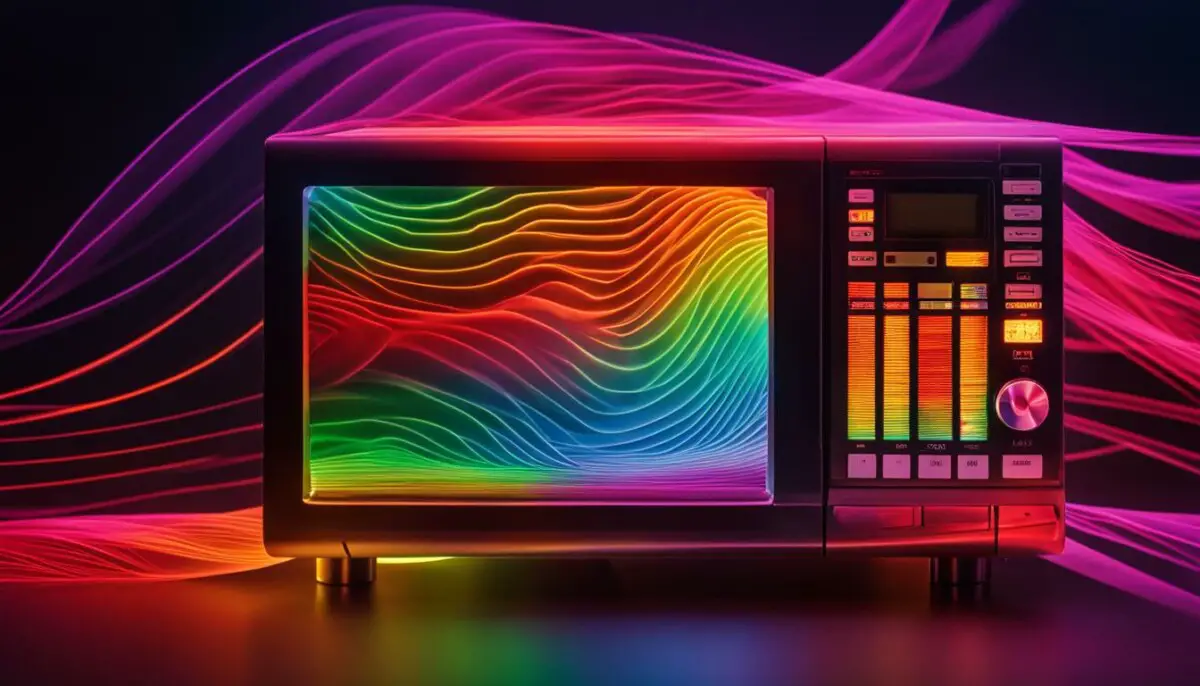Last Updated on 5 months by Francis
Have you ever wondered if microwaves are the same as infrared radiation? While they both fall under the category of electromagnetic radiation, there are some key differences to consider. Let’s dive deeper into the world of microwaves and infrared radiation to unravel this intriguing mystery.
When it comes to the electromagnetic spectrum, microwaves and infrared radiation do share a commonality. However, microwaves have longer wavelengths compared to infrared radiation. This distinction is crucial in understanding the technology behind microwaves and their various applications, particularly in cooking and heating.
So, what sets microwaves apart from infrared radiation? Well, the answer lies in their specific wavelengths and the effects they have on our environment. While microwaves are renowned for their ability to heat and cook food swiftly and uniformly, infrared radiation finds its utility in remote controls and thermal imaging.
Contents
Key Takeaways:
- Microwaves and infrared radiation belong to the electromagnetic spectrum.
- Microwaves have longer wavelengths compared to infrared radiation.
- Microwaves are commonly used for cooking and heating, while infrared radiation serves various applications like remote controls and thermal imaging.
- Understanding the science behind microwaves and their difference from infrared radiation enhances our knowledge of their applications and benefits.
The Concept of Radiation and Light
Radiation is a term that encompasses the emission of subatomic particles and pure energy, including visible light. It is often associated with nuclear reactors and nuclear radiation, but its definition extends far beyond that. In the context of electromagnetic radiation, all forms of light, from gamma rays to microwaves and infrared radiation, are considered types of radiation.
“All forms of light, including gamma rays, X-rays, microwaves, and infrared radiation, are types of radiation.”
The understanding of radiation as a broader term allows us to appreciate the concept of electromagnetic radiation and its relevance to various fields, including physics, chemistry, and technology.
“All forms of light, including gamma rays, X-rays, microwaves, and infrared radiation, are types of radiation.”
Types of Electromagnetic Radiation
The electromagnetic spectrum encompasses a wide range of forms of light. Microwaves, X-rays, radio waves, ultraviolet light, and infrared radiation all fall within this spectrum. While visible light is the light that humans can perceive, other animals can perceive different forms of light beyond the visible range.
It’s important to note that microwaves and infrared radiation have longer wavelengths than visible light. Microwaves are commonly used for cooking and heating, while infrared radiation finds applications in areas such as remote controls and thermal imaging.
| Type of Light | Wavelength | Applications |
|---|---|---|
| Microwaves | 1 millimeter to 1 meter | Cooking, heating |
| Infrared radiation | 1 micrometer to 1 millimeter | Remote controls, thermal imaging |
| X-rays | 100 picometers to 10 nanometers | Medical imaging, airport security |
| Ultraviolet light | 10 nanometers to 400 nanometers | Sunburn, fluorescence |
| Visible light | 400 to 700 nanometers | Vision, color perception |
| Gamma rays | Less than 100 picometers | Medical treatments, sterilization |
Exploring Different Forms of Light

The electromagnetic spectrum encompasses a wide range of light, including microwaves, X-rays, radio waves, ultraviolet light, and infrared radiation. While visible light is the form of light that humans can see, other animals have the ability to perceive different forms of light. Microwaves and infrared radiation, in particular, have longer wavelengths compared to visible light.
Microwaves are commonly used for cooking and heating due to their ability to penetrate and heat food quickly and uniformly. On the other hand, infrared radiation is utilized in various applications, such as remote controls and thermal imaging. Understanding these different forms of light and their characteristics is key to comprehending their unique uses and functionalities.
“The electromagnetic spectrum is like a vast palette of light, with each form having its own distinct properties and applications,” explains Dr. Katherine Johnson, a physicist specializing in light and radiation.
“Microwaves, with their longer wavelengths, are perfect for heating food efficiently. Meanwhile, infrared radiation allows us to see heat and control devices remotely. These forms of light have revolutionized various industries and continue to advance technology.”
Dr. Johnson’s research focuses on exploring the interactions between light and matter, shedding light on the fascinating properties and applications of different forms of light.
| Form of Light | Wavelength Range | Applications |
|---|---|---|
| Microwaves | 1 millimeter to 1 meter | Cooking, heating, wireless communication |
| X-rays | 0.01 to 10 nanometers | Medical imaging, security screening |
| Radio waves | 1 millimeter to 100 kilometers | Broadcasting, telecommunications |
| Ultraviolet light (UV) | 10 to 400 nanometers | Sterilization, mineral analysis, forensic investigations |
| Infrared radiation | 700 nanometers to 1 millimeter | Thermal imaging, remote controls, night vision |
Unlocking the Potential of Microwaves and Infrared Radiation
Scientists and engineers continue to push the boundaries of microwave and infrared technology, finding new ways to harness their unique properties. From advancements in wireless communication and medical imaging to improvements in energy efficiency and security systems, these forms of light play a crucial role in shaping the world we live in.
“Exploring and understanding different forms of light is like unraveling the mysteries of the universe,” says Dr. Johnson.
“By deepening our knowledge of microwaves and infrared radiation, we can unleash their full potential and pave the way for even more innovative applications in the future.”
As researchers delve deeper into the fascinating world of light, endless possibilities await, promising a brighter and more interconnected future.
The Magical Material That Blocks Microwaves and Infrared
Scientists have made a groundbreaking discovery in the field of materials science – a material that can effectively block both microwaves and infrared radiation. This innovative material, inspired by the properties of squid skin, has the ability to transition between a transparent and opaque state when stretched or contracted. The implications of this development are far-reaching, with potential applications in various industries, including defense, electronics, and construction.
The material is composed of a base material embedded with silver nanowires. This combination allows it to effectively block microwaves and other electromagnetic waves. By manipulating the material’s structure through stretching or contracting, it can switch from being transparent to becoming opaque, effectively controlling the passage of light and heat. This remarkable property opens up possibilities for creating stealth materials, protecting electronic devices from electromagnetic interference, improving energy efficiency in buildings, and safeguarding against microwave weapons.
“This material has the potential to revolutionize multiple industries,” says Dr. Sarah Thompson, a leading materials scientist involved in the research. “Its ability to selectively block both microwaves and infrared radiation, coupled with its controllable transparency, makes it invaluable for applications where shielding and visibility are both crucial.”
Stealth Materials
One of the most exciting applications of this material is in the development of stealth materials. By blocking both microwaves and infrared radiation, it can render objects invisible to radar and thermal imaging. This can have significant implications in military applications, where stealth technology is vital for strategic advantage and protection. The material’s ability to transition between transparent and opaque states further enhances its potential for stealth applications, as it allows for controlled visibility when needed.
In addition to its use in stealth technology, the material also holds promise in other areas. Its ability to block microwaves can be utilized to shield sensitive electronic devices from electromagnetic interference. This is particularly important in industries such as telecommunications and aerospace, where the performance of electronic components can be compromised by external electromagnetic waves. Furthermore, the material’s controllable transparency can be leveraged to improve energy efficiency in buildings by selectively blocking or allowing heat and light transmission.
| Applications | Advantages |
|---|---|
| Stealth technology | – Blocks both microwaves and infrared radiation – Controllable transparency – Renders objects invisible to radar and thermal imaging |
| Electronics | – Shields sensitive electronic devices from electromagnetic interference – Prevents performance degradation – Enhances reliability |
| Construction | – Improves energy efficiency in buildings – Controls heat and light transmission – Reduces reliance on artificial heating and cooling systems |
A New Material with Remarkable Properties

Researchers have made a breakthrough in material science with the development of a two-layer film that showcases remarkable properties. This magic material consists of silver nanowires and a stretched elastomer, and it offers unique capabilities that have never been seen before.
When contracted, this material has the ability to block light, trap infrared heat, and shield up to 99.9% of microwaves. Its exceptional properties make it an ideal choice for a wide range of applications where these characteristics are desired.
However, what truly sets this material apart is its ability to transition into a transparent state when stretched. In this state, it allows light, infrared heat, and microwaves to pass through. This extraordinary behavior opens up endless possibilities for its use in various technologies and industries.
Table: Properties of the Magic Material
| Material State | Properties |
|---|---|
| Contracted | Blocks light, traps infrared heat, shields microwaves |
| Stretched | Becomes transparent, allows light, infrared heat, and microwaves to pass through |
This material has the potential to revolutionize various industries, from healthcare to telecommunications. Its unique ability to switch between blocking and allowing the passage of different forms of radiation makes it a game-changer in the field of materials science.
The applications for this magic material are vast. It can be used in wireless electrocardiography signals, enabling medical professionals to monitor heart activity wirelessly and non-invasively. Additionally, it can be utilized for thermal regulation, providing enhanced comfort in clothing and other temperature-sensitive products. The material’s transparency in its stretched state also opens up possibilities for movement tracking in virtual reality and augmented reality applications.
The development of this material marks a significant step forward in the field of materials science. Its unique combination of properties makes it a versatile tool for various industries, offering new opportunities for technological advancements and innovation.
The Standard Model of Cosmology and Dark Energy

The expanding universe and the nature of its acceleration have long puzzled cosmologists. The current leading theory in cosmology, known as the Lambda CDM model, provides a framework for understanding the universe’s expansion and introduces the concept of dark energy. Dark energy is believed to be responsible for the accelerated expansion, and it is often characterized by a cosmological constant.
The Lambda CDM model combines the cosmological constant with cold dark matter to explain the large-scale structure and early expansion of the universe. However, recent measurements of the expansion rate, known as the Hubble tension, have challenged the predictions of the model and prompted further research.
While the Lambda CDM model has been successful in explaining many aspects of the universe’s evolution, there is still much to learn about dark energy and its properties. Scientists continue to explore alternative explanations and modifications to existing models to reconcile the discrepancies and gain a deeper understanding of the universe’s expansion.
The Mystery of the Universe’s Accelerating Expansion

One of the most intriguing phenomena in the field of cosmology is the accelerating expansion of the universe. Through observations of distant galaxies and their redshift, astronomers have confirmed that the universe is not only expanding but also accelerating in its expansion. This discovery has raised profound questions about the nature of the universe and the forces at play.
The concept of redshift is key to understanding the accelerating expansion of the universe. Redshift occurs when light from distant galaxies is stretched as the universe expands, causing the light to shift towards the red end of the spectrum. By analyzing the degree of redshift, astronomers can determine the velocity and distance of these galaxies. It became clear that the farther the galaxies are, the faster they appear to be receding from us. This observation led to the realization that the universe’s expansion is not only ongoing but also accelerating.
The driving force behind this accelerated expansion is still unknown and referred to as dark energy. Dark energy is a hypothetical form of energy that permeates the universe and counteracts the gravitational pull of matter, causing the expansion to accelerate. Its exact nature and behavior remain a mystery, and scientists have been actively researching and developing theories to explain its existence. The accelerating expansion of the universe challenges our current understanding of physics and demands further investigation and exploration.
The Hubble Tension and Future Research
The accelerating expansion of the universe, driven by an enigmatic force called dark energy, has presented cosmologists with a captivating mystery that defies our current knowledge. Yet, this mystery has also sparked curiosity and initiated a new era of research and exploration in the field of cosmology.
Despite the progress made in understanding the expanding universe, there are still unresolved questions and inconsistencies that challenge existing models. One of the notable discrepancies is known as the Hubble tension, which refers to the discrepancy between the measured expansion rate of the universe and the predicted rate based on the Lambda CDM model.
Scientists are actively working to refine and modify existing models to account for the accelerating expansion and reconcile the Hubble tension. New theories and hypotheses are being explored, pushing the boundaries of our understanding and paving the way for exciting discoveries in the future. The mystery of the universe’s accelerating expansion continues to captivate scientists and drive the quest for a deeper understanding of the cosmos.
The Mystery of the Universe’s Accelerating Expansion – Key Takeaways
- The universe is not only expanding but also accelerating in its expansion.
- Redshift, observed in distant galaxies, indicates the accelerating expansion by stretching light as the universe expands.
- The driving force behind the accelerating expansion is a mysterious form of energy called dark energy.
- The exact nature and behavior of dark energy remain unknown, spurring ongoing research and exploration.
- The Hubble tension, a discrepancy in the measured and predicted expansion rates, challenges current models and inspires the development of new theories.
Cosmic Distance and Time
The study of cosmic distance and redshift in galaxies provides valuable insights into the expansion of the universe. Astronomers analyze the redshift of light emitted by faraway galaxies to determine their distance and velocity. The higher the redshift, the farther back in time the light originates, allowing us to observe the universe in its early stages. This understanding of redshift and its correlation with time and distance is crucial for comprehending the ever-expanding cosmos.
The Cosmic Microwave Background (CMB) radiation is a significant source of information about the early universe. It is a remnant of the intense heat that pervaded the universe shortly after the Big Bang, and it can be detected in the form of microwave radiation. By studying the CMB, scientists can gather insights into the composition, age, and evolution of the universe. The redshift of the CMB is an essential tool for understanding the expansion history of the universe and the influence of dark energy.
In observational cosmology, different redshift ranges are classified as high or low redshift galaxies. High redshift galaxies, with redshift values greater than 1, are located farther away and closer to the early stages of the universe. They provide valuable data on the early universe’s formation and evolution. On the other hand, low redshift galaxies, with redshift values less than 1, are relatively closer to us and provide insights into the later stages of cosmic development.
| Redshift Range | Galaxy Classification |
|---|---|
| 0 – 1 | Low Redshift Galaxies |
| 1+ | High Redshift Galaxies |
The classification of galaxies based on redshift allows astronomers to observe and analyze the universe at different stages of its expansion, providing valuable information about its growth, structure, and evolution over time.
Key Points:
- Redshift analysis of distant galaxies helps determine their distance and velocity, providing insights into the expansion of the universe.
- The Cosmic Microwave Background (CMB) radiation is a remnant of the early universe and serves as a valuable source of information.
- High redshift galaxies offer insights into the early stages of the universe, while low redshift galaxies provide information about later cosmic development.
Conclusion
When it comes to microwaves, there are a few key points to remember. Firstly, microwaves are distinct from infrared radiation, although they both fall under the electromagnetic spectrum. Microwaves are commonly used in cooking and heating due to their ability to quickly and evenly heat food. This makes them a convenient and efficient option for many households.
One of the advantages of using microwaves is their energy efficiency. They consume less energy compared to traditional cooking methods, such as stovetops or ovens. Additionally, microwaves offer the benefit of preserving nutrients in food. The rapid heating process minimizes nutrient loss, ensuring that your meals retain their nutritional value.
When it comes to food safety, microwaves are generally considered safe when used properly. It’s important to follow the manufacturer’s instructions and use microwave-safe containers to prevent any potential hazards. By understanding the science behind microwaves and their difference from infrared radiation, we can appreciate their applications and enjoy the advantages they bring to our daily lives.
FAQ
Are microwaves and infrared radiation the same thing?
No, microwaves and infrared radiation are not the same thing. While both are forms of electromagnetic radiation, they have different wavelengths and properties.
What is the difference between microwaves and infrared radiation?
Microwaves have longer wavelengths than infrared radiation. Microwaves are commonly used for cooking and heating, while infrared radiation is utilized for applications such as remote controls and thermal imaging.
Can microwaves and infrared radiation be blocked?
Yes, scientists have developed a material that can block both microwaves and infrared radiation. This material contains silver nanowires embedded in a base material and can transition between transparent and opaque states by being stretched or contracted.
What can this material be used for?
This material has the potential to be used for creating stealth materials, protecting electronic devices, improving energy efficiency in buildings, and safeguarding against microwave weapons.
What are some remarkable properties of the new material?
The new material, made of silver nanowires and a stretched elastomer, can block light, trap infrared heat, and shield up to 99.9% of microwaves when contracted. When stretched, it becomes transparent and allows light, infrared heat, and microwaves to pass through.
What is the current leading theory in cosmology?
The current leading theory in cosmology is the Lambda CDM model, which explains the accelerating expansion of the universe. It incorporates the concept of dark energy and cold dark matter to account for the expansion.
What is dark energy?
Dark energy is a mysterious form of energy that is believed to be driving the accelerating expansion of the universe. It is often described by a cosmological constant, a property of spacetime.
Why is the accelerating expansion of the universe a mystery?
The accelerating expansion of the universe, supported by observations of distant galaxies and their redshift, is faster than predicted by the leading theory. This inconsistency, known as the Hubble tension, has led to further research and potential modifications to existing models.
How do astronomers study the expansion of the universe?
Astronomers study the expansion of the universe by observing distant galaxies and analyzing the redshift of the light emitted by these galaxies. The higher the redshift, the farther back in time the light is coming from, allowing astronomers to study the early stages of the universe.
Are microwaves safe for food preparation?
Yes, when used properly, microwaves are safe for food preparation. They offer advantages such as convenience, energy efficiency, and the preservation of nutrients in food.
Source Links
- https://thedebrief.org/magical-material-that-blocks-microwaves-and-infrared-heat-also-shifts-from-transparent-to-translucent/
- https://medium.com/the-philipendium/you-too-are-a-constant-source-of-radiation-4ed5da4e8bfb
- https://scitechdaily.com/einsteins-puzzle-unraveling-the-mystery-of-the-universes-accelerating-expansion/









